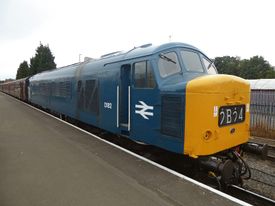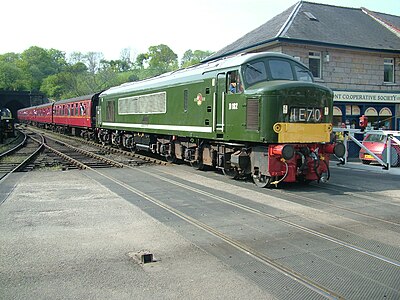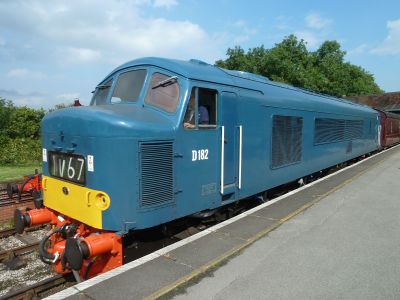| BR Class 46 D182 | |
|---|---|
 D182 | |
| Built By | British Railways, Derby Works |
| Configuration | 1Co-Co1 |
| Power type | Diesel-electric |
| Status | In service |
| Loco Number | D182 |
| Other Numbers | 46045, 97404 |
| History | |
| Built | 1962 |
| Type | Class 46 |
| 1984 | Withdrawn for departmental use |
Contents
BR Class 46
The BR Class 46 diesel-electric locomotive was originally classified as the Type 4 and was the third of the Sulzer 'Peak' classes. The introduction of TOPS saw the type designated as Class 46. A total of 56 were built by BR Derby between 1961 and 1963 as part of BR's modernisation plans to replace steam locomotives.
The first Sulzer Type 4 class, which became the Class 44, was built between 1959-60. All 10 members of the class were named after mountains, giving rise to the nickname 'Peak' which carried over to the subsequent Class 45 (built 1960-62) and Class 46.[note 1] The Class 46 were built with the same Sulzer 12-cylinder 12LDA28-B engine as the Class 45s, rated at 2,500 bhp, but with Brush transmissions. This arrangement was later developed further with the ubiquitous Class 47.
The class were used on both goods and passenger services, with the latter notably including heavy cross-country expresses between the north east and south west. They were fitted with steam powered train heating boilers but, unlike some of the Class 45s, never fitted with electric train supply.
The members of the class were all withdrawn between 1977 and 1984. One was subsequently destroyed in 1984 in a staged collision as part of a nuclear flask test, with all but three being scrapped. Of the three surviving examples, Pete Waterman's D172 (46035) became the first preserved diesel locomotive to receive mainline certification in 1994.
Service
D182 entered service in September 1962 at Gateshead, where it remained allocated for its entire service career. As built, it was fitted with vacuum brakes and steam heat. It was converted to dual braking in August 1970 by the addition of air braking. By that time it carried BR Blue livery with the full yellow cab front.[1]
The introduction of TOPS saw the locomotive renumbered as 46045 in October 1973.
On 22 March 1982, 46045 was recorded as being available at Loughborough, having recently been at Millerhill in Scotland.[2][note 2]
During 1984 the locomotive was 'stopped' on numerous occasions with traction motor and other power issues. After the locomotive failed at Taunton on 24 November 1984 while hauling the 07.50 Bristol to Penzance service, it was withdrawn and returned to Derby.
Research department use
On withdrawal it was renumbered 97404 and transferred to Research department stock during December 1984, running until 1986 when it was stored after suffering a generator flashover[2]. It remained in Departmental stock until September 1990[3].
Preservation
D182 is owned by Peak Locomotive Company Limited and is normally based at the Midland Railway Centre, Butterley. It retains its steam heating boiler.
The locomotive has carried several different liveries in preservation. The first picture below shows D182 in 2008 at Grosmont on the NYMR, then in BR green livery. The second picture shows D182 in 2016 at Butterley in BR livery with half yellow cab front.
D182 subsequently underwent an overhaul, with the overhauled generator, turbocharger and intercoolers being refitted in October 2020.[4]. Since that overhaul the locomotive is now in BR blue livery with full yellow cab front.
SVR use
D182 arrived on the SVR in May 2022 for the Spring Diesel Festival. In July 2022 the SVR announced that, given the then issues with coal supply, it had also taken the opportunity to retain the locomotive on hire, providing another locomotive for use during the main season.[5] Its boiler meant a further period of hire, to cover winter services, was also mooted.
In October 2022 a director of the owners announced on Facebook: "In the coming weeks, the loco will return to the Midland Railway for the overhauled steam heating boiler to be installed and commissioned. Several other repairs will also be made including to the cooling system which caused the loco to fail at the Autumn diesel bash. If all goes to plan, the loco will return to the SVR next year ready to steam." It left the SVR on 3 November.
Peak Locomotive Company
The Peak Locomotive Company is a private limited company No. 01593522. It was incorporated on 26 October 1981 as the Peak Locomotive Preservation Company Limited, adopting its present name in 1992.[6]
Other company locomotives
- In 1982 the company acquired Type 4 D4 Great Gable (later numbered 44004).[7]
- 45041 Royal Tank Regiment was purchased from Pete Waterman in February 1996.[8]
- 45108 passed into the company's ownership in 2008[9].
All have visited the SVR for galas.
See also
Notes
References
- ↑ BR Database (retrieved 19 August 2022)
- ↑ 2.0 2.1 Derby Sulzers website (Retrieved 16 July 2022)
- ↑ Locomotive Directory 2021, Key Publishing Ltd, ISBN 978 1 8082 017 1
- ↑ Midland Railway Diesel Group on Facebook
- ↑ Branch Lines, July 2022
- ↑ Companies House
- ↑ Peak Locomotive Company, Ged Holmes
- ↑ Great Central Railway website (Retrieved 21 October 2022)
- ↑ East Lancashire Railway Diesel Group (Retrieved 22 October 2022)
Links
- BR Class 46 on Wikipedia
- D182 on BR Database

